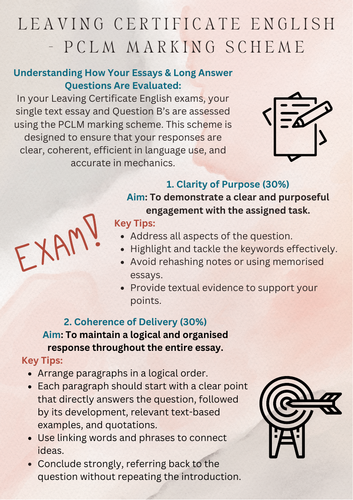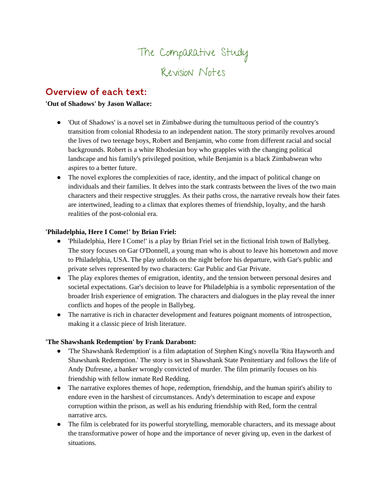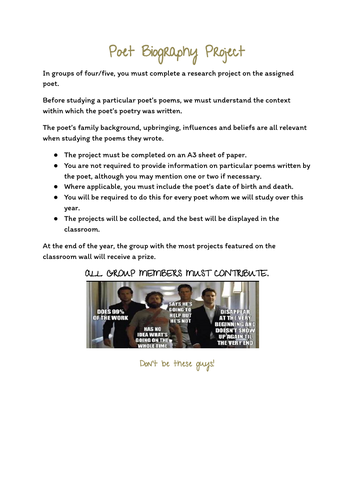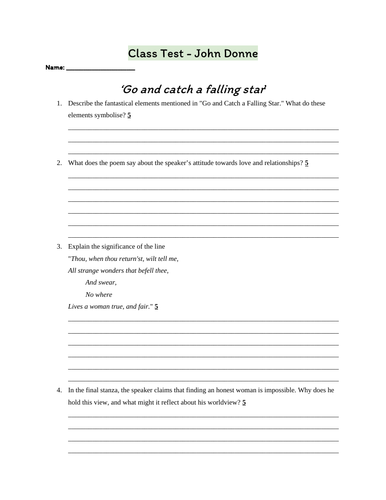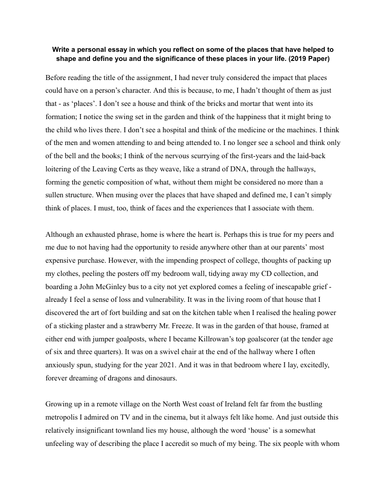
39Uploads
19k+Views
19k+Downloads
English

Ordinary Level Comparative Revision - Where the Crawdads Sing and The Shawshank Redemption
This comprehensive 36-page document delves into a detailed comparison of two prominent texts featured in the Leaving Certificate comparison course: “The Shawshank Redemption” by Frank Darabont and “Where the Crawdads Sing” by Delia Owens. Focused on the thematic elements of Isolation and the dynamic portrayal of Hero, Heroine, and Villain, this resource provides an in-depth exploration of both texts, offering valuable insights for students and teachers alike.
Content Highlights:
Thematic Comparison: Explores the theme of Isolation in both texts, dissecting how this theme is depicted, its significance, and its impact on characters and narrative development.
Character Analysis: Provides comprehensive character notes for key figures in each text, shedding light on their motivations, complexities, and roles within the themes of Isolation and Hero, Heroine, Villain.
Key Moments Examination: Breaks down pivotal moments in both texts, highlighting scenes that intricately illustrate themes of Isolation and the portrayal of heroic, villainous, and protagonist characters.
Quotations Analysis: Presents key quotes from the texts, analysing their contextual significance, thematic relevance, and how they contribute to character development and storytelling.
Sample Answers: Offers sample answers to exemplify how to structure responses, drawing comparisons between the texts based on the themes and characters explored.
Benefits for Students and Teachers:
Comprehensive Analysis: Provides an in-depth study of themes and characters in both texts, aiding a thorough understanding for students preparing for exams.
Educational Guidance: Offers teachers a valuable resource for structuring lesson plans and guiding students through comparative analysis.
Exam Preparation: Equips students with valuable insights, character notes, and sample answers to enhance their exam preparation and essay writing skills.
This resource serves as an invaluable tool for those studying and teaching the Leaving Certificate comparative course, offering a detailed exploration of thematic elements and character dynamics across two compelling texts.**

Leaving Certificate English'23 Revision
Studied Poetry 2
Patrick Kavanagh 2-7
Approaching the Question (2012) 7
Paula Meehan 9-16
Approaching the Question (Sourced Online) 15-16
Derek Mahon 17-25
Approaching the Question (2013) 25-26
Elizabeth Bishop 27-37
Approaching the Question (2009) 37-38
William Butler Yeats 39-46
Approaching the Question (2014) 46-47
Language to use when writing about poetry 47-49
Unseen Poetry 50-55
2020 - Sample Answer 50-52
2013 - Sample Answer 52-43
2017 - Sample Answer 54-55
The Comparative (PHIC!, LB, ADH) 56
Theme: Freedom 56-60
General Vision and Viewpoint 61-69
Language to use when writing your comparative essay 69-70
Macbeth 71
Character Analysis 71-74
Key Quotes 74-76
Key Themes 76-85
2023 Mock - Sample Answer 85-86
What might I be asked? Questions and points to consider 87-91

The Shawshank Redemption Bundle
Explore the depths of “The Shawshank Redemption” with this comprehensive study bundle, tailored for students and educators preparing for the Leaving Certificate exams. Packed with essential resources, analyses, and quizzes, this bundle offers an in-depth understanding of the film’s themes, characters, key moments, and more.
Included in this Bundle:
Comparative Notes: Detailed notes covering both Ordinary and Higher Level Leaving Certificate course modes, providing comprehensive insights into various aspects of the film.
Character Charts: Comprehensive charts dissecting the main characters’ traits, motivations, and development throughout the film.
Quiz: A comprehensive quiz featuring 55 multiple-choice questions, accompanied by an answer key to test understanding and knowledge retention.
Character Notes: In-depth notes focusing on the individual characters, their significance, and relationships within the storyline.
Plot Summary and Comprehension Questions: A concise summary of the plot accompanied by thought-provoking comprehension questions to reinforce understanding.
Key Themes Analysis: Detailed exploration of the film’s central themes, providing critical insights into the underlying messages and motifs.
Key Quotes Compilation: Analysis of 10 pivotal quotes from the film, exploring their relevance, thematic connections, and application in answering exam questions.
Key Moments Analysis: Examination of crucial moments in the film, offering guidance on using these moments effectively to answer exam questions.
Why Choose This Bundle?
This comprehensive bundle equips students and educators with an extensive array of resources meticulously designed to aid in a thorough understanding of “The Shawshank Redemption.” Ideal for exam preparation, essay writing, and deepening appreciation of the film’s nuances, this bundle serves as an indispensable study companion.
Perfect for Leaving Certificate Students and Teachers:
Whether you’re a student aiming for exam success or a teacher seeking comprehensive teaching materials, this bundle offers a wealth of resources designed to enhance understanding, analysis, and critical thinking skills around this iconic film.
Unlock the secrets of “The Shawshank Redemption” and prepare for success with this all-inclusive study bundle!

Transition Year English - Full Year Module
The newly available Transition Year English resource is a comprehensive 200-page PDF booklet designed to make teaching the curriculum engaging and seamless. It covers various modules, including short stories, poetry, drama, film studies, blogging, and sports journalism. The resource also includes a separate study guide for “The Playboy of the Western World,” which is part of the comparative module.
The comparative module features the novella “Foster” and suggests screening the Irish language film “An Cailín Ciúin” based on the novella. The booklet provides a one-page document for students with essential class information and material requirements.
The resource is designed to be organized week by week using poly pocket documents in a folder. It contains clear instructions on what to print and how many copies to make, with online access to additional resources and YouTube videos.
Apart from the core content, the booklet suggests “Down Day material,” like films and documentaries for more relaxed teaching days. Throughout the year, there are activities for students to design posters related to the content, creating a soothing atmosphere with projected fireplaces and relaxing music. Additionally, there is a five-page handout for students to reflect on their work experience. Overall, this resource aims to provide engaging and diverse material for Transition Year English.

Tips for Effective Question B Presentation
Description:
This resource comprises ten informative slides designed to help Leaving Certificate students effectively approach Question B on their exam paper. Question B is a critical component of the examination, and this resource offers a concise yet comprehensive overview of how to tackle it successfully.

Leaving Certificate English - PCLM Marking Scheme
This two-page worksheet breaks down the PCLM marking scheme into easily digestible insights, helping you understand how your essays are assessed.

The Comparative - Out of the Shadows, PHIC, Shawshank Redemption
Comparative Analysis of “Out of Shadows,” “Philadelphia, Here I Come,” and “The Shawshank Redemption” - Leaving Certificate Resource
Description:
This comprehensive resource is designed for Leaving Certificate students and English teachers seeking an in-depth understanding of three literary works: “Out of Shadows” by Jason Wallace, “Philadelphia, Here I Come” by Brian Friel, and “The Shawshank Redemption” by Stephen King (adapted into a film by Frank Darabont). The resource offers revision notes, a comparative overview, and sample answers, providing a valuable aid in preparing for the Leaving Certificate English exams.
Key Features:
Revision Notes for Each Text:
Detailed notes for “Out of Shadows,” “Philadelphia, Here I Come,” and “The Shawshank Redemption,” including character analysis, plot summaries, and thematic exploration.
Comparative Overview:
An in-depth comparative analysis of the three texts, highlighting similarities and differences in themes, characters, and literary techniques.
Comparative Notes on Themes:
Comprehensive notes discussing common themes across the texts, such as identity, freedom, and redemption, providing a deeper understanding of how these themes are presented in each work.
Comparative Notes on Cultural Context:
Exploring the cultural and historical contexts in which the texts are set, allowing students to appreciate how the societal backdrop influences the narratives.
Sample Answers:
Sample answers to Leaving Certificate-style questions, giving students insights into structuring their responses and scoring well in their exams.
Preparation for Comparative Study:
This resource equips students to excel in the comparative study section of the Leaving Certificate English exam, enabling them to draw connections between different texts effectively.
Whether you are a Leaving Certificate student preparing for your English exams or a teacher guiding your students through these literary works, this resource is a valuable tool for enhancing your understanding of the chosen texts and achieving success in your exams. It provides a comprehensive and comparative approach to three engaging and thought-provoking pieces of literature.

Introduction to OL English
An introduction to the OL English course for 5th year students and a guide on what texts to purchase and where.
Follow @rescueresource on instagram for an editable version of this resource!

Literary techniques Quiz
This resource is a valuable toolkit for English teachers, designed to enhance their teaching of literary devices and language elements to students of various levels. It includes two meticulously crafted tests, each catering to different levels of proficiency. Additionally, answer keys are provided for easy grading. The PowerPoint presentation, which complements the tests, is available for separate purchase or can be bundled with this resource.
Features of the Resource:
Differentiated Tests: The package consists of two tests, carefully tailored to meet the needs of students at different levels of proficiency. This allows teachers to choose the most suitable test for their class, whether they are teaching beginners or advanced students.
Comprehensive Coverage: The tests cover a wide range of essential literary devices and language elements, ensuring that students are exposed to key concepts fundamental to English language and literature. These include hyperbole, imagery, alliteration, metaphor, personification, rhyme, rhetorical questions, and theme.
Answer Keys: For each test, detailed answer keys are provided, making grading efficient and straightforward.
Flexible PowerPoint Option: The PowerPoint presentation, which complements the tests, can be purchased separately or as part of a convenient bundle. It features visual aids, examples, and explanations to support teachers in delivering engaging lessons on each topic covered in the tests.
Versatile Usage: Whether used as pre-assessment tools to gauge students’ prior knowledge, as formative assessments to track their progress, or as summative evaluations to measure their mastery of literary devices, these tests offer versatility to teachers.
Time-Saving and Convenient: As a ready-made resource, this package saves teachers valuable time that would otherwise be spent creating assessments from scratch.
Engaging Learning Experience: The combination of tests and a visually appealing PowerPoint presentation ensures that students remain engaged while learning about these important literary concepts.

Eavan Bolan - Sample Essay
“Boland makes effective use of symbols and metaphors to explore personal experiences and deliver penetrating truths about society.” (2017 Paper)

Louder than Words - First Year Scheme of Work
This scheme of work covers the academic year and includes a diverse range of texts and activities to engage and develop students’ language skills. It encompasses poetry, drama, novels, short stories, oral texts, and written communication. The curriculum aims to enhance critical thinking, language proficiency, and a deep appreciation for literature and communication skills. It is divided into thematic units with specific learning outcomes and assessments.

Poetry Biography Project
"Poet Biography Project: Understanding the Poet’s World
This engaging project invites students to delve into the lives and backgrounds of renowned poets, gaining valuable insights into the context that shaped their poetry. Working in groups of four or five, students are tasked with researching an assigned poet and presenting their findings on an A3 sheet of paper.
Key Objectives:
Contextual Understanding: Explore the poet’s family background, upbringing, influences, and beliefs to comprehend the environment in which their poetry evolved.
Biographical Details: Include the poet’s birth and death dates where applicable.
Fostering Research Skills: Encourage students to conduct thorough research to create informative presentations.
Classroom Display: Projects will be collected, with the best ones featured prominently in the classroom.
Friendly Competition: Students will have the chance to compete, and the group with the most projects displayed at the end of the year will receive a prize.
This resource not only enhances students’ knowledge of poetry but also cultivates research and presentation skills. It offers an exciting opportunity for creative exploration and deeper comprehension of the poets whose work they’ll encounter throughout the year."

John Donne - Ordinary Level - Class Test
This resource is a “Weekly Test” for the study of John Donne’s poems, specifically focusing on “Go and Catch a Falling Star” and “The Flea.” It is designed for students, particularly those preparing for Irish Leaving Certificate at Ordinary Level. The test consists of a series of structured questions that encourage critical thinking and analysis of these two poems.
For “Go and Catch a Falling Star,” students are asked to describe the fantastical elements in the poem and analyze their symbolism. They also explore the speaker’s attitude towards love and relationships, the significance of a repeated line, and the speaker’s view of honesty in women.
For “The Flea,” students examine the central metaphor and how it is used for persuasion, the symbolism of the flea in the lovers’ relationship, the speaker’s feelings about physical intimacy, and the significance of a specific line. Additionally, they are prompted to share their impression of the speaker based on their reading of the poem.
The test provides a total score out of 60 and includes space for a parent’s signature, indicating its suitability for classroom use or as a practice resource for students preparing for their exams.

Merchant of Venice class test and Revision Notes
*EDITED Apologies! Notes were created using an inaccurate version so there were three errors that have been noted and corrected! Apologies!
*
Class test (1hr class)
The test comprises five sections, each addressing specific aspects of William Shakespeare’s play “The Merchant of Venice.”
Section 1: Plot Structure
Requires identifying the key components of Freytag’s Pyramid (Exposition, Rising Action, Climax, Falling Action, Denouement) within the play. Specific examples from the text are requested to support the identification of each component.
Section 2: Character Relationships
Focuses on the relationship between Antonio and Shylock, inquiring how this relationship contributes to the overall conflict in the play. A separate question explores the impact of the friendship between Bassanio and Antonio on the plot and characters.
Section 3: Tension in a Scene
Asks for an analysis of the scene with the most tension in the play. The student is prompted to describe the setting, characters involved, factors contributing to the tension, and how the tension is ultimately resolved within that scene.
Section 4: Themes
Explores the themes of mercy and justice in the play. It asks for examples of characters or scenes embodying these themes and how they contribute to the overall message of the play. Another question addresses the impact of prejudice on Shylock and his interactions with others.
Section 5: Key Plot Details
Examines the significance of the casket test within the play, focusing on its impact on the plot and characters. Another question prompts students to recall the events leading up to the courtroom scene and analyze how the trial affects the characters and resolves the play’s conflicts.
Overall, the test aims to evaluate students’ understanding of the plot structure, character relationships, thematic elements, and significant plot details within “The Merchant of Venice.” Students are required to provide specific examples and detailed explanations to demonstrate their comprehension of the play’s nuances and themes.
Revision Notes Document:
The revision notes serve as a study guide summarising essential themes, character dynamics, key scenes, and their significance within the play.
It explores and analyses various elements, including the relationship between Antonio and Shylock, the impact of friendship between Bassanio and Antonio, themes of mercy and justice, the concept of prejudice and its effects on Shylock, the significance of the casket test, and the pivotal courtroom scene.
Both documents collectively provide a comprehensive resource for students preparing for the Junior Certificate exam. The test offers a structured way to assess students’ understanding of the play’s narrative structure, while the revision notes consolidate key themes, character relationships, and significant scenes, aiding in a deeper understanding and analysis of the text.

Pre-reading - Salem Witch Trials Web-Quest
Resource Description:
Explore History with a Modern Twist – The Salem Witch Trials Web Quest!
Step back in time and immerse yourself in the enigmatic era of the Salem Witch Trials through this engaging and interactive web quest. Designed for today’s tech-savvy students, this resource allows them to use their smartphones as powerful tools for historical exploration.
Key Features:
Mobile-Friendly: This web quest is specifically designed for smartphones, making it accessible and engaging for today’s students who are always on the go.
Solo or Teamwork: Students can choose to embark on this journey individually or collaborate with a partner, fostering both independence and teamwork skills.
In-Depth Exploration: Through a series of thought-provoking questions and challenges, students will delve deep into the history, context, and intricacies of the Salem Witch Trials.
Historical Context: Gain insights into the social, cultural, and religious factors that contributed to the witch trials of the late 1600s.
Interactive Challenges: Interactive elements and multimedia resources provide an immersive learning experience that goes beyond traditional textbooks.
Critical Thinking: Encourage critical thinking and analysis as students work their way through a series of inquiries and puzzles.
Flexible Learning: Ideal for in-class use, homework assignments, or as an extra credit opportunity, allowing for flexible integration into your curriculum.
By using their smartphones as research tools, students will not only expand their knowledge of history but also enhance their digital literacy skills. Unlock the mysteries of the Salem Witch Trials in a way that resonates with today’s tech-savvy generation. Embrace the power of modern technology to make history come alive!

John Donne - Ordinary Level Poetry Notes
These comprehensive notes cover two of John Donne’s renowned poems, “The Flea” and “Go and catch a falling star.” They are designed to assist ordinary level English teachers and students in understanding and analyzing these classic works of literature. The notes encompass various aspects of both poems, including their structures, themes, literary techniques, and deeper meanings. They are invaluable resources for teachers looking to teach these poems effectively and for students seeking to gain a deeper insight into their content.
Detailed Summary: The notes provide a thorough summary of “The Flea,” breaking it down stanza by stanza to ensure a clear understanding of its narrative and themes.
Analysis of Themes: The notes delve into the central themes of “The Flea,” such as love, desire, persuasion, and moral implications. They offer insights into how these themes are explored and developed within the poem.
Interpretation and Imagery: The notes discuss the poem’s use of metaphor and symbolism, particularly the extended metaphor of the flea. They help students grasp the deeper meanings and messages conveyed through these literary devices.
Character Analysis: The notes examine the speaker and subject within “The Flea,” focusing on the perspectives and motivations of the speaker and the woman. This analysis aids in understanding their roles and the dynamics of their interaction.
Discussion Questions: Comprehension questions are included for “The Flea,” encouraging critical thinking and classroom discussion. These questions prompt students to engage with the poem’s themes and characters on a deeper level.
Relevance for Modern Readers: The notes address the question of whether “The Flea” remains meaningful for contemporary readers, emphasizing its enduring themes and universal appeal.
Sample Questions and Answers: Sample exam-style questions for “The Flea” are presented, along with model answers, to help students practice their analytical and essay-writing skills.
“Go and catch a falling star” Notes:
In-depth Analysis: These notes provide a detailed analysis of “Go and catch a falling star.” They cover the poem’s structure, themes, imagery, and literary style.
Comprehension Questions: Similar to “The Flea” notes, this section includes comprehension questions that encourage critical thinking and discussion among students.
Comparison to Contemporary Music: Just as in “The Flea” notes, these notes draw a modern-day comparison, linking the themes and style of “Go and catch a falling star” to a contemporary song, making the poem’s relevance to today’s readers apparent.
Sample Questions and Answers: Sample exam-style questions for “Go and catch a falling star” are provided, along with model answers, to help students practice their analytical and essay-writing skills for this poem.

Unlocking Literary Magic: 13 Essential Literary Terms
Dive into the enchanting world of literature with our colorful and engaging resource designed for students in Junior Cycle through Ordinary Leaving Certificate English. “Unlocking Literary Magic” is your key to understanding and mastering 13 essential literary terms that will transform your reading and writing skills.
What’s Inside:
Alliteration: Discover the power of sound in literature. Alliteration occurs when words with the same initial consonant sounds are used close together, like “Sally sells seashells by the seashore.”
Assonance: Explore the musical side of words. Assonance is the repetition of vowel sounds in nearby words, such as “fleet feet sweep by sleeping geese.”
Hyperbole: Experience the exaggeration. Hyperbole uses extravagant language to emphasize a point, like “I’m so hungry I could eat a horse!”
Metaphor: Uncover hidden meanings. A metaphor compares two unlike things without using “like” or “as,” e.g., “Her smile is a ray of sunshine.”
Onomatopoeia: Hear the words come alive. Onomatopoeia imitates sounds, like “buzz,” “meow,” or “boom.”
Personification: Breathe life into objects. Personification gives human characteristics to non-human things, such as “The wind whispered through the trees.”
Sibilance: Savor the sound of hissing. Sibilance is the repetition of hissing “s” and “sh” sounds, creating a serene or sinister atmosphere.
Rhyme: Dance to the rhythm of words. Rhyme is the repetition of similar sounds in words, like “cat” and “hat.”
Rhetorical Questions: Engage your readers. Rhetorical questions are asked for effect or to provoke thought, not necessarily to receive an answer, such as “Who doesn’t love a good story?”
Imagery: Paint pictures with words. Imagery uses vivid descriptions to appeal to the senses, like “The aroma of freshly baked bread filled the air.”
Simile: Make comparisons sparkle. A simile compares two things using “like” or “as,” such as “Brave as a lion.”
Repetition: Emphasize, emphasize, emphasize. Repetition involves repeating words or phrases for impact, like “Never, never, never give up” (Winston Churchill).
Symbolism: Decipher hidden meanings. Symbolism is the use of symbols or objects to represent deeper ideas, like a dove representing peace.
Why You’ll Love It:
Colorful and visually appealing.
Concise definitions and clear examples.
Helpful for essays, exams, and creative writing.
Enhance your literary analysis skills.

2017 - Question B - Sample Answer
QUESTION B
**Your school Principal has agreed to your suggestion to display three poems, or extracts from three poems, on the 2017 Leaving Certificate Higher Level English poetry course, in your school. You have been asked to choose the poetry and decide how and where it will be displayed. Write an article for your school’s website in which you explain your choice of poetry, your ideas for its display and the impact you hope this project will have on the school community. (50)

Personal Essay - 2019 Higher Level Leaving Certificate
Write a personal essay in which you reflect on some of the places that have helped to shape and define you and the significance of these places in your life.

The Outsiders - Graphic Oraniser
Introducing the ideal companion for your classroom when exploring “The Outsiders” - our one-page graphic organiser! This meticulously crafted A3 chart is designed with both students and teachers in mind, catering to the needs of educators like you who are passionate about teaching English.
This comprehensive graphic organiser is a valuable tool for dissecting S.E. Hinton’s classic novel. It’s ingeniously structured, with a dedicated box for each chapter, enabling students to record key events, character developments, and central themes as they read. What sets it apart is its adaptability, offering three flexible boxes for teachers to customise – whether for novel feedback, concise reviews, or memorable quotes from the text.
But that’s not all; we’ve incorporated captivating images and symbols related to ‘The Outsiders’ into the design, enhancing visual engagement and aiding memory retention. Hang it proudly on your classroom wall, turning it into an attractive and informative centerpiece for your students.
As an English teacher, you understand the value of visual aids and organised note-taking, and this graphic organiser is your perfect ally in the teaching journey. It will guide your students through the novel’s intricate narrative, making their learning experience not only more engaging but also more effective. So why wait? Elevate your “The Outsiders” lessons with this indispensable tool today.






